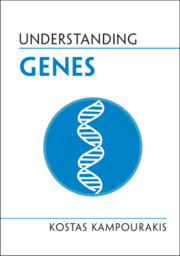Refine search
Actions for selected content:
37 results
Why sequence the genome of every species? A view from evolutionary biology
-
- Journal:
- Journal of the Marine Biological Association of the United Kingdom / Volume 105 / 2025
- Published online by Cambridge University Press:
- 08 September 2025, e97
-
- Article
-
- You have access
- Open access
- HTML
- Export citation
Chapter 7 - Neurogenetics
-
-
- Book:
- Essential Neuroscience for Psychiatrists
- Published online:
- 12 March 2025
- Print publication:
- 20 March 2025, pp 224-259
-
- Chapter
- Export citation
Intraspecific karyotypic variability among 12 Indian accessions of Momordica charantia L. (bitter gourd): a medicinally important vegetable crop
-
- Journal:
- Plant Genetic Resources / Volume 22 / Issue 5 / October 2024
- Published online by Cambridge University Press:
- 20 May 2024, pp. 286-294
-
- Article
- Export citation
Chapter 29 - Polar Body Biopsy for IVF
- from Section 6 - Embryo Assessment: Morphology and Beyond
-
-
- Book:
- Principles of IVF Laboratory Practice
- Published online:
- 07 August 2023
- Print publication:
- 24 August 2023, pp 213-217
-
- Chapter
- Export citation
Genomic evaluation of threshold traits in different scenarios of threshold number using parametric and non-parametric statistical methods
-
- Journal:
- The Journal of Agricultural Science / Volume 161 / Issue 1 / January 2023
- Published online by Cambridge University Press:
- 26 January 2023, pp. 109-116
-
- Article
- Export citation
Chapter 6: - Genetics
- from Part I - Introduction to the Scientific Perspective on the Past
-
- Book:
- The Evolution of Everything
- Published online:
- 03 November 2022
- Print publication:
- 24 November 2022, pp 77-89
-
- Chapter
- Export citation
1 - Biological Identification
-
- Book:
- Understanding Forensic DNA
- Published online:
- 02 September 2022
- Print publication:
- 22 September 2022, pp 1-16
-
- Chapter
-
- You have access
- HTML
- Export citation

Understanding Genes
-
- Published online:
- 17 February 2022
- Print publication:
- 04 November 2021
5 - What Genes “Do”
-
- Book:
- Understanding Genes
- Published online:
- 17 February 2022
- Print publication:
- 04 November 2021, pp 121-148
-
- Chapter
- Export citation
3 - The Devolution of the Gene Concept
-
- Book:
- Understanding Genes
- Published online:
- 17 February 2022
- Print publication:
- 04 November 2021, pp 65-95
-
- Chapter
- Export citation
6 - The Dethronement of Genes
-
- Book:
- Understanding Genes
- Published online:
- 17 February 2022
- Print publication:
- 04 November 2021, pp 149-181
-
- Chapter
- Export citation
1 - The Public Image of Genes
-
- Book:
- Understanding Genes
- Published online:
- 17 February 2022
- Print publication:
- 04 November 2021, pp 1-30
-
- Chapter
- Export citation
4 - There Are No “Genes For” Characteristics or Disease
-
- Book:
- Understanding Genes
- Published online:
- 17 February 2022
- Print publication:
- 04 November 2021, pp 96-120
-
- Chapter
- Export citation
2 - The Origin and Evolution of the Gene Concept
-
- Book:
- Understanding Genes
- Published online:
- 17 February 2022
- Print publication:
- 04 November 2021, pp 31-64
-
- Chapter
- Export citation
Long-read sequencing improves assembly of Trichinella genomes 10-fold, revealing substantial synteny between lineages diverged over 7 million years
-
- Journal:
- Parasitology / Volume 144 / Issue 10 / September 2017
- Published online by Cambridge University Press:
- 06 June 2017, pp. 1302-1315
-
- Article
- Export citation
Aberrant subclavian artery origin in tetralogy of Fallot with pulmonary stenosis is associated with chromosomal or genetic abnormality
-
- Journal:
- Cardiology in the Young / Volume 24 / Issue 3 / June 2014
- Published online by Cambridge University Press:
- 04 June 2013, pp. 478-484
-
- Article
- Export citation
Chapter 25 - Genetics of stimulant dependence
-
-
- Book:
- Principles of Psychiatric Genetics
- Published online:
- 05 October 2012
- Print publication:
- 13 September 2012, pp 306-315
-
- Chapter
- Export citation
11 - Measurement of CNS atrophy
- from Section II - Clinical trial methodology
-
-
- Book:
- Multiple Sclerosis Therapeutics
- Published online:
- 05 December 2011
- Print publication:
- 20 October 2011, pp 128-149
-
- Chapter
- Export citation
Chromosomes of Cichlasoma trimaculatum (male), Heros managuense (female) and their hybrid offspring
-
- Journal:
- Chinese Journal of Agricultural Biotechnology / Volume 6 / Issue 3 / December 2009
- Published online by Cambridge University Press:
- 29 January 2010, pp. 265-270
- Print publication:
- December 2009
-
- Article
- Export citation
